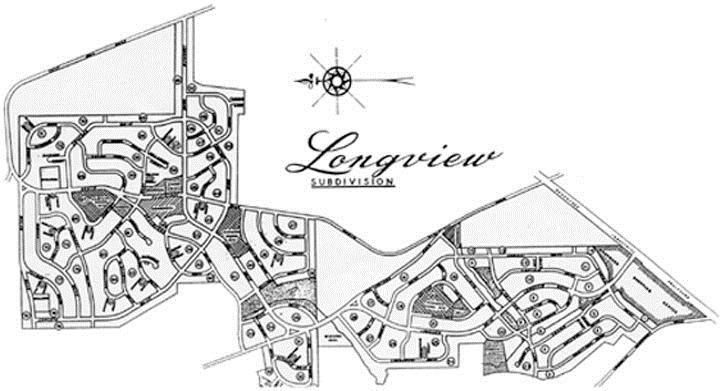
History
For a deep dive into the history of Huntley Hills including details on the land, original plans and historical resources, please view below.
The Roswell Railroad
The Roswell Railroad operated for 40 years from 1881 to 1921. It was nicknamed “the Buck Line” (there is a development in Dunwoody called “Buckline Crossing”). The tracks ran right through Huntley Hills from what was at one time Roswell Junction (now Chamblee) up to Roswell, where it stopped short of the Chattahoochee River.
Traces of the rail system remain yet today. The rail line was built by the Roswell Manufacturing Company to expedite freight to and from their mills in Roswell, however, they never built a railroad bridge over the Chattahoochee River. It was also used by passengers, including Theodore Roosevelt, who rode the train in 1905 to visit his mother at Bulloch Hall in Roswell.
The illustration is by Chuck Brown and is found in “History of the Roswell Railroad.” The book was written by Michael D. Hitt and copyrighted in 1994. The book is currently out of print; however, a copy is kept in the Reference Section of the Roswell Public Library. The map shows the route of the railroad through Huntley Hills, with the current streets drawn in.
Longview Vision
Carol Hoffner, who grew up in Huntley Hills, discovered an original sales brochure from Longview Realty in an old family box. Remarkably well preserved, the sales folder details all the latest conveniences and features found in their house plans, from the hardwood floors and concrete driveways to the custom-made kitchen cabinets; from the plastic countertops and electric dishwashers to the choice of decorator colors for interior and exterior painting. The sales office, with a display room and subdivision model, was located in the now empty building behind the Firestone Store that Timeless Furniture used to occupy.
Carol remembers riding around in a golf cart with the sales person to see models and select a lot. The subdivision drawing below shows a plan for a 928 acre community subdivided into 2,014 homes. As you can see, the community was planned to extend across what is now I-285 (which wasn’t in the plans then) up into Dunwoody in the area on both sides of North Peachtree just across the expressway.
An original drawing of Huntley Hills Subdivision in Chamblee, GA
The brochure also contains sketches and original layout plans for each model – 35 in all. Our subdivision was obviously the initial phase of this larger community and the south half of it was eventually built pretty much as planned.
There are a few interesting differences to note. Most streets have the original name except that Seaman Circle was to have been called Oregon Drive; Admiral Way was to be Craven Lane; Forrestal was to be Saratoga Drive and Longview Way was to be Suffolk Lane. There must have been a parochial school planned for the current public school site as the drawing shows a church on the corner of what is now Forrestal and Seaman Circle. The proposed shopping center did develop into Chamblee Plaza. Our neighborhood park on Longview was originally planned to be a park, with two additional parks on Ellwyn and Plantation.
Mr. Long built the first phase of homes in the late 1950’s up to Plantation Lane, including the pool which was for community use. He actually lived here until 1962 at 3659 Greenhill Drive. He did not build on the lots across the street from him. Even on today’s county records, homes in this area are still referred to as Longview Subdivision. In 1962 Long sold the project to Michael Huntley. The name was changed and other builders took over and completed the subdivision as far as North Shallowford. That is the reason for the distinct difference in home structures on both sides of Plantation Lane.
An Illustrated History of Huntley Hills
Ellen Rankin, a Huntley Hills resident and graduate student in the Heritage Preservation Program at Georgia State University, has written a beautifully illustrated history of the development of Longview and Huntley Hills, with particular concentration on the original Ranch homes in the first developed section of the neighborhood.


